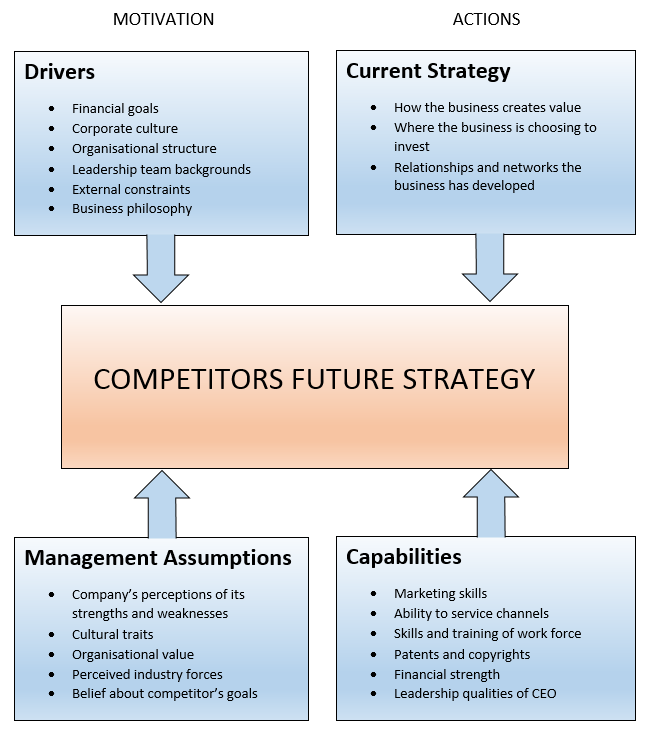Competitive Intelligence: Four Corner’s Analysis

What is this tool?
There is no business nowadays that lives in an isolation. There is a huge competition in the business world that forces any organization to look at the competitors and analyze them in order to take strategic decisions. The four corners analysis is a tool designed by Michael Porter that helps in determining an organization’s future strategy. Further, this tool is divided into four corners which are Drivers, Assumptions, Capabilities, and Strategy. Those four corners are categorized into two main categories which are Motivation and Actions.
When and Why is this tool used?
There are several competitive analysis tools that help identify the core competencies of each organization, however, those tools are looking for the short term and not the long one. To clarify, most of the competition tools are evaluating the current state of an entity yet, the four corners analysis asses the company’s future strategy which is more precise because it makes the corporation one step ahead of its competitor. By using the four corners, you will know your competitors’ motivation and consequently its current strategy that is powered by its capabilities. This analysis will aid you in formulating the company’s trend or predictive course of action.
How is this tool used?
Step1: Identify the motivation of your competitor
There are two corners that must be analyzed in the motivation part.The first one is the drivers, in this section you are required to state what drives and motivates your competitor to move forward. You have to underline your competitor’s targets as to know if they are likely to change their strategy or not in the future. Moreover, the second one is the management assumptions which is how your competitor believes about themselves. You should analyze the way the company perceives itself such as its strengths and weaknesses. How the company identifies itself is a mean of how it takes the strategic decisions.
Step 2: Identify the possible actions of your competitor
The second part of the analysis is about the predictable actions that a competitor might take. This section is also divided into two subsections; current strategy and capabilities. Firstly, the current strategy emphasizes the company’s investments, value creation, networking, and relationships. In this subsection, you have to detect the strategy that the company follows as to determine their future strategy as well. Secondly, the capabilities part is all about the corporation’s resources. In this stage, you need to write down the abilities and assets that a company can use to accomplish their targets and implement their strategy.
Step3: Identify the company’s trend
The last thing that you need to do in this analysis is to combine all the information together and start making the analysis. The four corners are interrelated and they affect each other in a direct or indirect way. Consequently, you have to draw conclusions and correlations from the data in order to figure out the company’s future strategy.
Hints
This tool is very helpful yet, it is not commonly used because not so many people know about it. That’s why a suggestion about the usage of this tool is to use the sub-points in each category as to facilitate the mission. Furthermore, this analysis can also be used for the company’s itself and not the competitor.

Case Study
Ahmed is an entrepreneur who wants to start a new business by doing a travel mobile app that offers customized travel services starting from choosing the country till the way back. A major problem that Ahmed knows he might face is the fierce competition in the field and the rapid change in the industry. Therefore, he had to conduct the four corners analysis for his direct competitor which is “Google Trips” as to be one step ahead in the competition. Ahmed started to search for information about the application and dig deep in order to know their drivers and management assumptions. Actually, he came up with the following:

Then, Ahmed moved to the possible actions that Google Trips might take in the future based on their current strategy and their capabilities. Further, he summed the info in the following:

Lastly, Ahmed grouped all his assumptions that he wrote in the four corners analysis and then, he was able to predict the future strategy of Google trips. After the analysis, he assumed the following:
- The company is customer oriented.
- The company has a long-term strategy which is innovation for the best experience.
- The company is willing to invest a huge amount of money as to develop its business.
- The company has the calibers to help in its innovation stage.
After looking at these facts, Ahmed must be very cautious while entering the market because of the strengths of its competitors yet, he must take advantage of its flaws. Also, he can easily predict the next step of his competitor as he knows his strategy so he can always be the first mover.
Pros and Cons
As for the advantages and disadvantages of this tool, the four corners is a very insightful in terms of the future decisions and tactics of an entity. It helps formulate a trend for the business and not a snapshot of the SWOT analysis. Nevertheless, as mentioned before it is not widely used and therefore, a lot of people do not know about it.





























































EgyptInnovate site is not responsible for the content of the comments